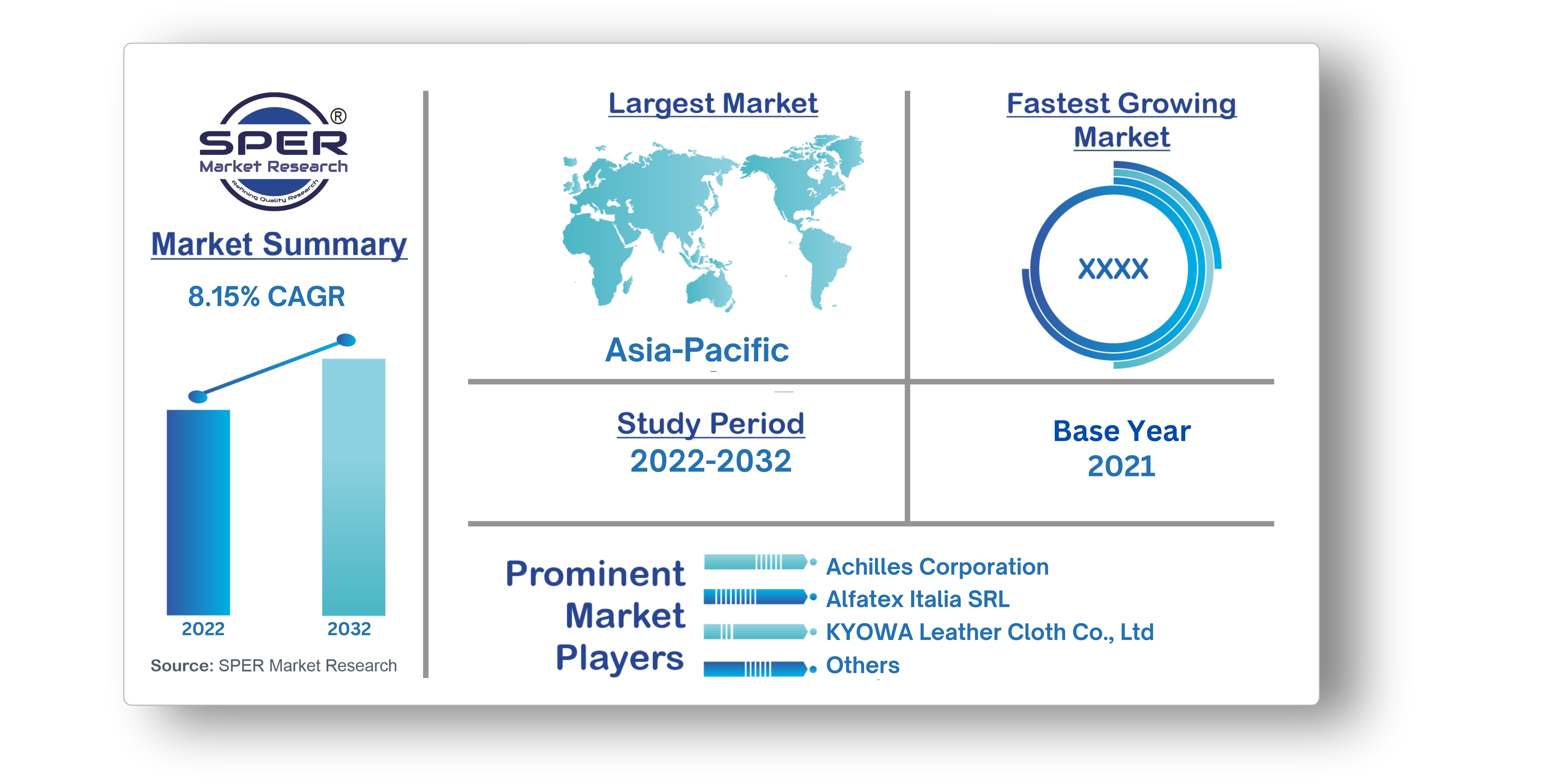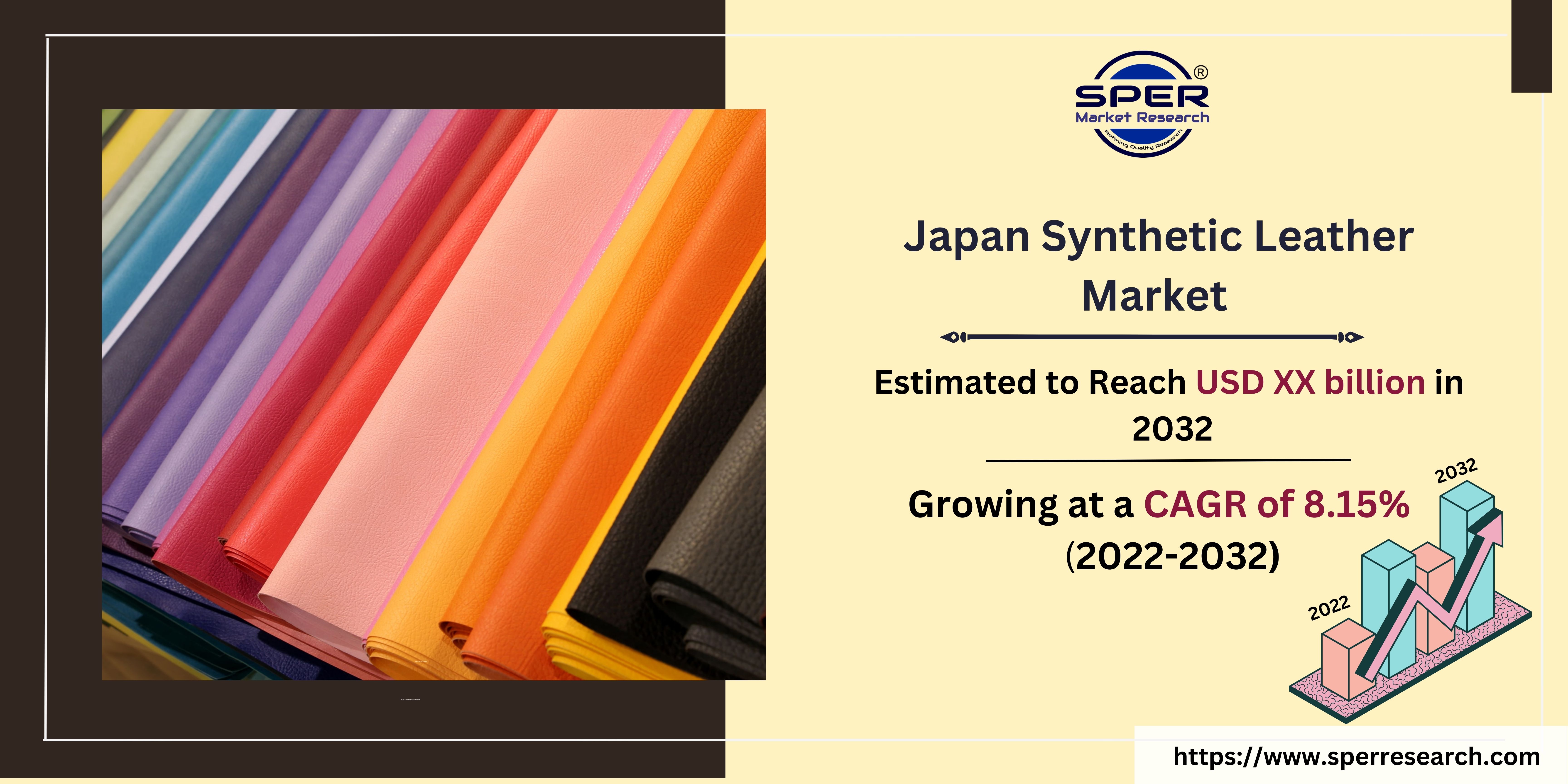
Japan Synthetic Leather Market Growth, Trends, Size, Scope, Revenue, Challenges and Future Share
Japan Synthetic Leather Market Size- By Product, By End User- Regional Outlook, Competitive Strategies and Segment Forecast to 2032
| Published: Apr-2023 | Report ID: CHEM2359 | Pages: 1 - 108 | Formats*: |
| Category : Chemical & Materials | |||


| Report Metric | Details |
| Market size available for years | 2019-2032 |
| Base year considered | 2021 |
| Forecast period | 2022-2032 |
| Segments covered | By Product, By End User |
| Regions covered | Tokyo, Osaka, Nagoya, Fukuoka, Sendai, Hiroshima, Naha, Kitakyushu, Kumamoto, Others |
| Companies Covered | Achilles Corporation, Air Water Inc., Alfatex Italia SRL, Ashai Kasei Corporation, Fujian Polytech Technology Corp., Ltd., H.R. Poly coats Pvt. Ltd., Kuraray Co., Ltd., KYOWA Leather Cloth Co., Ltd., Mayur Uniquoters Limited, Nan Ya Plastics Corporation, San Fang Chemical Industry Co., Ltd., SEIREN Co. Ltd., Teijin Limited, Toray Industries, Inc., Ultra Fabrics Holdings Co. Ltd., Zhejiang Hexin Holdings Ltd., Others |
- Fashion Industry
- Automotive Industry
- Animal right activist user
- Polyurethane (PU)
- Polyvinyl Chloride (PVC)
- Automobile
- Footwear
- Furnishing
- Garments
- Interior
- Luxury Goods
- Sporting Goods
- Others
- Tokyo
- Osaka
- Nagoya
- Fukuoka
- Sendai
- Hiroshima
- Naha
- Kitakyushu
- Kumamoto
- Japan Synthetic Leather Market Size (FY’2019-FY’2032)
- Overview of Japan Synthetic Leather Market
- Segmentation of Japan Synthetic Leather Market By Product (Polyurethane, Polyvinyl Chloride)
- Segmentation of Japan Synthetic Leather Market By End User (Automobile, Footwear, Furnishing, Garments, Interior, Luxury Goods, Sporting Goods, Others)
- Statistical Snap of Japan Synthetic Leather Market
- Growth Analysis of Japan Synthetic Leather Market
- Problems and Challenges in Japan Synthetic Leather Market
- Competitive Landscape in the Japan Synthetic Leather Market
- Impact of COVID-19 and Demonetization on Japan Synthetic Leather Market
- Details on Recent Investment in Japan Synthetic Leather Market
- Competitive Analysis of Japan Synthetic Leather Market
- Key Players in the Japan Synthetic Leather Market
- SWOT Analysis of Japan Synthetic Leather Market
- Japan Synthetic Leather Market Future Outlook and Projections (FY’2019-FY’2032)
- Recommendations from Analyst
1.1. Scope of the report1.2. Market segment analysis
2.1 Research data source2.1.1 Secondary data2.1.2 Primary data2.1.3 SPER’s internal database2.1.4 Premium insight from KOL’s2.2 Market size estimation2.2.1 Top-down and Bottom-up approach2.3 Data triangulation
4.1. Driver, Restraint, Opportunity and Challenges analysis4.1.1 Drivers4.1.2 Restraints4.1.3 Opportunities4.1.4 Challenges4.2. COVID-19 Impacts of the Japan Synthetic Leather Market
5.1. SWOT analysis5.1.1 Strengths5.1.2 Weaknesses5.1.3 Opportunities5.1.4 Threats5.2. PESTEL analysis5.2.1 Political landscape5.2.2 Economic landscape5.2.3 Social landscape5.2.4 Technological landscape5.2.5 Environmental landscape5.2.6 Legal landscape5.3. PORTER’S five forces analysis5.3.1 Bargaining power of suppliers5.3.2 Bargaining power of Buyers5.3.3 Threat of Substitute5.3.4 Threat of new entrant5.3.5 Competitive rivalry5.4. Heat map analysis
6.1 Japan Synthetic Leather Manufacturing Base Distribution, Sales Area, Product Type6.2 Mergers & Acquisitions, Partnerships, Product Launch, and Collaboration in Japan Synthetic Leather Market
7.1 Polyurethane (PU)7.2 Polyvinyl Chloride (PVC)
8.1 Automobile8.2 Footwear8.3 Furnishing8.4 Garments8.5 Interior8.6 Luxury Goods8.7 Sporting Goods8.8 Others
9.1 Japan Synthetic Leather Market Size and Market Share by Region (2019-2025)9.2 Japan Synthetic Leather Market Size and Market Share by Region (2026-2032)9.3 Tokyo9.4 Osaka9.5 Nagoya9.6 Fukuoka9.7 Sendai9.8 Hiroshima9.9 Naha9.10 Kitakyushu9.11 Kumamoto9.12 Others
10.1 Achilles Corporation10.1.1 Company details10.1.2 Financial outlook10.1.3 Product summary10.1.4 Recent developments10.2 AIR WATER, Inc.10.2.1 Company details10.2.2 Financial outlook10.2.3 Product summary10.2.4 Recent developments10.3 Alfatex Italia SRL10.3.1 Company details10.3.2 Financial outlook10.3.3 Product summary10.3.4 Recent developments10.4 Asahi Kasei Corporation10.4.1 Company details10.4.2 Financial outlook10.4.3 Product summary10.4.4 Recent developments10.5 Fujian Polytech Technology Corp., Ltd.10.5.1 Company details10.5.2 Financial outlook10.5.3 Product summary10.5.4 Recent developments10.6 H.R.Polycoats Pvt. Ltd.10.6.1 Company details10.6.2 Financial outlook10.6.3 Product summary10.6.4 Recent developments10.7 Kuraray Co., Ltd10.7.1 Company details10.7.2 Financial outlook10.7.3 Product summary10.7.4 Recent developments10.8 KYOWA Leather Cloth Co., Ltd.10.8.1 Company details10.8.2 Financial outlook10.8.3 Product summary10.8.4 Recent developments10.9 Mayur Uniquoters Limited10.9.1 Company details10.9.2 Financial outlook10.9.3 Product summary10.9.4 Recent developments10.10 Nan Ya Plastics Corporation10.10.1 Company details10.10.2 Financial outlook10.10.3 Product summary10.10.4 Recent developments10.11 San Fang Chemical Industry Co., Ltd.10.11.1 Company details10.11.2 Financial outlook10.11.3 Product summary10.11.4 Recent developments10.12 SEIREN Co. Ltd.10.12.1 Company details10.12.2 Financial outlook10.12.3 Product summary10.12.4 Recent developments10.13 Teijin Limited10.13.1 Company details10.13.2 Financial outlook10.13.3 Product summary10.13.4 Recent developments10.14 Toray Industries, Inc.10.14.1 Company details10.14.2 Financial outlook10.14.3 Product summary10.14.4 Recent developments10.15 Ultra fabrics Holdings Co. Ltd.10.15.1 Company details10.15.2 Financial outlook10.15.3 Product summary10.15.4 Recent developments10.16 Zhejiang Hexin Holdings Ltd.10.16.1 Company details10.16.2 Financial outlook10.16.3 Product summary10.16.4 Recent developments10.17 Others10.17.1 Company details10.17.2 Financial outlook10.17.3 Product summary10.17.4 Recent developments
SPER Market Research’s methodology uses great emphasis on primary research to ensure that the market intelligence insights are up to date, reliable and accurate. Primary interviews are done with players involved in each phase of a supply chain to analyze the market forecasting. The secondary research method is used to help you fully understand how the future markets and the spending patterns look likes.
The report is based on in-depth qualitative and quantitative analysis of the Product Market. The quantitative analysis involves the application of various projection and sampling techniques. The qualitative analysis involves primary interviews, surveys, and vendor briefings. The data gathered as a result of these processes are validated through experts opinion. Our research methodology entails an ideal mixture of primary and secondary initiatives.



Frequently Asked Questions About This Report
PLACE AN ORDER
Year End Discount
Sample Report
Pre-Purchase Inquiry
NEED CUSTOMIZATION?
Request CustomizationCALL OR EMAIL US
100% Secure Payment






Related Reports
Our Global Clients
Our data-driven insights have influenced the strategy of 200+ reputed companies across the globe.




















